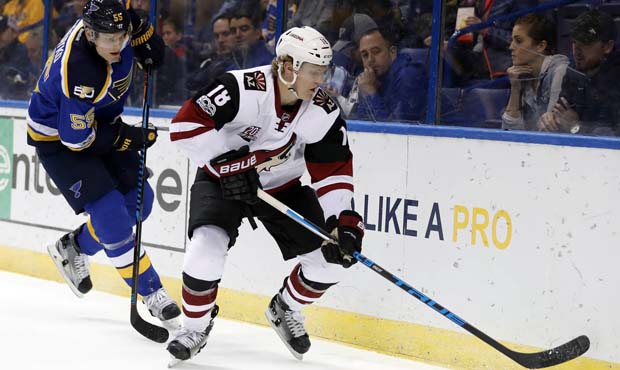Welcome to the second edition of the “Neutral Zone Notebook”, where Sports360AZ’s Andrew Bell explores and dives into local hockey storylines in Arizona every week.
We are almost a month into the NHL season and the Arizona Coyotes have a daunting road task ahead of them, while Arizona State just wrapped up two interesting exhibition games at Oceanside Arena. Let’s take a look at what’s going on around the valley on the ice.
Murchison and Romer’s Meeting With ASU, Keeping West Coast Kids Home
Ty Murchison and Matthew Romer of the U-18 United States National Development program stepped on the ice against their future teammates on Thursday and Friday at Oceanside Arena.
Arizona State, an independent program that is playing an all-road schedule against Big Ten opponents in 2020-21 due to the pandemic, finally had its first home games the last couple nights when the Sun Devils hosted two exhibition matchups against the U-18 U.S. National Development program.
The exhibition tune-ups will allow ASU to remain fresh in game action before it embarks on one final four-week road trip later this month. Another benefit of the two games is that the Sun Devil players and coaching staff will get an up and close, personal look at Murchison and Romer, who are two ASU commits playing for the U.S. program.
Although head coach Greg Powers wasn’t behind the bench for the two games due to COVID-19 protocols, he was watching the game from home very closely. The U.S. National Development Program showcases some of the top American junior hockey players from around the country every year.
“I think it speaks volumes to the recruiting efforts that we have and that our staff has put in place,” Powers said of his two commits on the U-18 team. “There was a day not very long ago where it was a pipe dream to look at the lineup card with the National Development Program and hope that one day we could have a pitchfork next to one of those kid’s names.”
Surely, it’s a unique experience for the two players to skate against players who they will be sharing a locker room with over the coming years. Both Murchison and Romer will arrive on campus for the 2021-22 season in Tempe.
Although Powers can’t comment publicly on Romer since he has not officially signed yet with ASU, he did make comments about Murchison’s game and his upbringing earlier this week. A Corona, California native, the 6-foot-2, left shot defenseman is one of a plethora of talented hockey players from the west coast.
Just this year alone on the United States World Juniors roster that won a gold medal in Edmonton, there were four players from the Golden State on the roster. In this weekend’s games, the U-18 team also featured three players from the west, with three hailing from California.
Similar to trying to keep local players home in college football, Powers sees the potential of west coast hockey talent. The program hosting two games against Harvard last year in Irvine, CA are an indication of that.
Despite all players leaving elsewhere for junior hockey, the sales pitch of keeping hockey talent in the west and going back somewhere close to home is something to sell, specifically when Arizona State is such a new program.
“California has always been on our radar to make a huge priority,” Powers said. “…There’s so many good players coming out of that state and I think the more we continue to legitimize our program with a building and going into a conference, and all the good things we have going on, I would expect more west coast kids to stay home.
“Even local kids, anyone coming in still didn’t grow up dreaming about playing college hockey at Arizona State…They probably grew up dreaming about playing for a blue blood program that’s been around for a long time so we have to continue to do what we’re doing and create a sense of pride for west coast kids where they say, ‘You know what? That’s where I want to go. I want to be part of this. I grew up on the west coast and they are the only west coast team. That’s who I want to play for.’ I think we’re moving in that direction, but that’s not something that happens overnight.”
Dealing With The Blues
Playing an NHL season during a pandemic doesn’t get much more wacky than what the Arizona Coyotes are about to go through over the next week.
After splitting two games with the St. Louis Blues on Tuesday and Thursday, the NHL announced that the Coyotes will be playing four more games against St. Louis due to COVID-19 issues with both the Minnesota Wild and Colorado Avalanche – the team’s next two road opponents.
Feb. 6 and 8 will be played in St. Louis, while Feb. 13 and 15 will be a return trip to Gila River Arena. It’s not how it was planned, but it’s what the Coyotes have to make due with.
If all the games are played out and there are no COVID issues between either side over the coming week, it’d the first time in NHL regular season history that two teams play each other six times in a row.
With four games already played against the Vegas Golden Knights and six matchups against St. Louis, the Coyotes are getting a heavy dose of the NHL’s western division heavyweights. The measuring sticks are going to be out as the games wear along against the Blues.
“Four against Vegas, six against St. Louis. That’s good stuff,” said Coyotes head coach Rick Tocchet with a chuckle. “It’s a good experience for people on our team to understand what it takes to win. The NHL is trying its best…the NHL, the St. Louis Blues, we put our heads together and said, ‘hey, it’s better to play and do this.’ We can’t go back and have two weeks off and then all of a sudden, back date all of these games. I think it’s best for everybody.”
Players couped up in hotel rooms in a cold midwest city for a week, same faces, same players hitting one another. Don’t be surprised to see the animosity and chippy play ramp up as these games carry on, just like when forward Johan Larsson dropped the gloves with Brayden Schenn in Saturday’s matchup.
First fight of the season for the #Yotes
As Tyson Nash put it, solid effort from Johan Larsson in this "punch in the face contest." pic.twitter.com/RrzVZNtqhQ
— Bally Sports Arizona (@BALLYSPORTSAZ) February 6, 2021
Behind a closeout defensive effort in the third period and two goals from Jakob Chychrun, the Coyotes upended the Blues for a second straight game on Saturday afternoon.
D-Vo’s Development
A 2014 second-round pick, Coyotes forward Christian Dvorak’s scoring prowess during his junior career with the Ontario Hockey League’s London Knights was electric.
Alongside current Toronto Maple Leaf Mitch Marner and Calgary Flame Matthew Tkachuk, Dvorak’s astounding 121 points in 59 games jumps out on a stat sheet when going over the Knight’s totals from their 2016 Memorial Cup title. Their line was lethal, and Dvorak was a big reason why as a captain of the team.
“D-Vo” is one of the important components of the Coyotes young nucleus. He’s shown flashes of his offense in juniors as a 200-foot player over his last few years in the NHL, but in order for the ‘Yotes to take a next step and try to stay in the hunt in the west this year, his contributions and consistency will be integral.
In his last few games, he’s showing that growth. Dvorak has six points in his last five games, including two goals apiece against Anaheim and St. Louis.
He’s done his damage in high-scoring areas, too, primarily in front of the net and on the Coyotes power play. He added two more points on Thursday night to put himself with good company among some of the league’s best scorers.
Christian Dvorak is 1 of 5 players (McDavid, Draisaitl, Pavelski, Matthews) to have 6 goals, 3 PPGs and 2 GWGs this season.
Dvorak has scored five goals in his past three games and is on a career-long three-game goal streak pic.twitter.com/Djoh6DOZNH
— Arizona Coyotes PR (@AZCoyotesPR) February 5, 2021
After struggling to find his scoring touch early, Dvorak reached out and asked for film of Boston Bruins forward Patrice Bergeron, who has made a living throughout his career finding the soft spots in opposing defenses and being all around the net. Dvorak’s goals in his last few games have been similar.
“D-Vo, since I’ve been here, every year he has just gotten better with his hockey IQ,” Tocchet said. “When I first got here, we went through that losing streak at the beginning of the year and he was throwing pucks away and we lost a couple games because D-Vo threw it away, but we kept putting him out there because I knew he was going to be a hell of a hockey player for us. Second of all, he wants to be a 200-foot, two-way hockey player. We watched video 10 days ago and his game wasn’t great early on and obviously you’ve watched his last four or five games, he’s really come into his own. He went himself and asked our video coach for Patrice Bergeron video clips…Those are the type of guys that he’s learning from and he’s getting rewarded. He’s putting the extra time in and he’s getting rewarded. I believe in karma. You work at your game and you are going to get good results. D-Vo is a poster child of it.”



